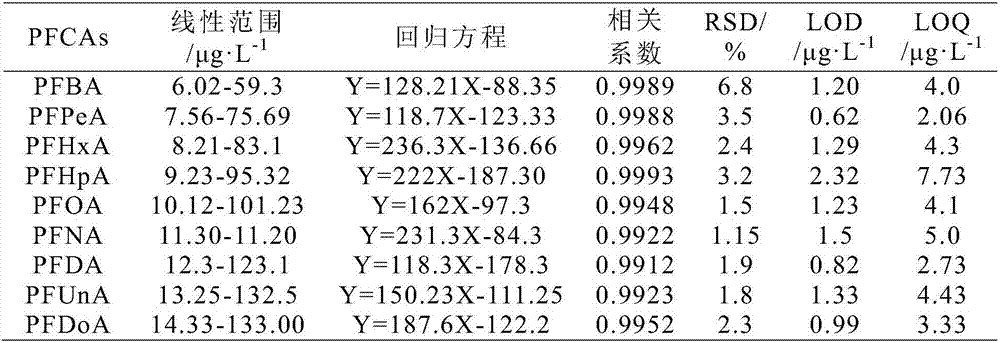Instrumental analysis pretreatment method of enriching perfluorinated carboxylic acid compound
A perfluorocarboxylic acid and instrumental analysis technology, applied in the field of analysis and detection, can solve problems such as large amount of organic reagents, influence on analysis results, and hazards to operators, and achieve the effects of less sample loss, high enrichment multiples, and improved accuracy
- Summary
- Abstract
- Description
- Claims
- Application Information
AI Technical Summary
Problems solved by technology
Method used
Image
Examples
Embodiment 1
[0046] Drawing of standard curve
[0047] (1) Configuration of standard solution: Accurately weigh the appropriate amount of nine kinds of samples including chromatographically pure PFBA, PFPeA, PFHxA, PFHpA, PFOA, PFNA, PFDA, PFUnA and PFDoA, dissolve them in n-hexane, and configure them into 0.001mol / L PFCA standard stock solution. Accurately pipette 10 mL each of the above nine PFCAs standard stock solutions, mix them into a 100 mL volumetric flask, and dilute to 100 mL with n-hexane to prepare a 0.0001 mol / L mixed standard mother solution containing nine PFCAs.
[0048] At the same time, take DFA and DCC and dissolve them in n-hexane, respectively, to prepare 0.001mol / L DFA stock solution and DCC stock solution, respectively pipette the DFA stock solution and DCC stock solution, place them in a 100mL volumetric flask, and dissolve them with n-hexane Dilute to 0.0001mol / L DFA solution and DCC solution. The prepared solutions above were stored at 4°C in the dark.
[0049]...
Embodiment 2
[0058] Detection of PFCAs Compound Type and Content in a Sewage Treatment Plant in Ningbo
[0059] Water samples were collected from a sewage treatment plant in Ningbo. After the water samples to be tested were filtered through a 0.45 μm aqueous microporous membrane, derivatization, magnetic separation and other pre-treatment processes were performed to obtain derivatives that could be detected on the machine, and then Perform chromatographic assays. The above-mentioned pretreatment and chromatographic determination were carried out according to the method of Example 1.
[0060] See Table 2 for the determination results of the type and content of PFCA in the sample and the recovery calculated after the addition of the standard.
[0061] Table 2: PFCA determination and standard addition recovery results in the water samples of Example 2
[0062]
Embodiment 3
[0064] Collect water sample from the same sewage treatment plant in embodiment 2, and embodiment 2 difference is:
[0065] Standard solution, DFA solution and DCC solution were prepared with ethyl acetate.
[0066] The process of activating the magnetic graphene oxide material is to add 0.15g of the magnetic graphene oxide material and 15ml of ammonia-methanol solution into a conical flask filled with 100mL of high-purity water, and ultrasonically disperse it to obtain the activated magnetic graphene oxide material. , the frequency of ultrasonic dispersion is 26kHz, the power is 5kw, and the time is 1min. .
[0067] When the sample is derivatized, the volume ratio of standard solution, DFA solution, DCC solution and magnetic graphene oxide material is 1:50:5:90, and the Erlenmeyer flask is fixed on the oscillator to fully shake for 20min at a temperature of 18°C. Derivatization process.
[0068] The desorbent added during vortex desorption is ethanol, the vortex oscillation...
PUM
 Login to View More
Login to View More Abstract
Description
Claims
Application Information
 Login to View More
Login to View More - R&D
- Intellectual Property
- Life Sciences
- Materials
- Tech Scout
- Unparalleled Data Quality
- Higher Quality Content
- 60% Fewer Hallucinations
Browse by: Latest US Patents, China's latest patents, Technical Efficacy Thesaurus, Application Domain, Technology Topic, Popular Technical Reports.
© 2025 PatSnap. All rights reserved.Legal|Privacy policy|Modern Slavery Act Transparency Statement|Sitemap|About US| Contact US: help@patsnap.com



